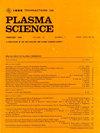气体压力和加速间隙长度对脉冲前真空等离子体电子束源发射特性的影响
IF 1.3
4区 物理与天体物理
Q3 PHYSICS, FLUIDS & PLASMAS
引用次数: 0
摘要
本文研究了加速间隙长度(AGL)对脉冲($500~\mu $ s)前真空等离子体阴极电子源在不同压力(4 ~ 30 Pa)和气体类型(Ar、N2、He)下的发射特性和缩弧放电(CAD)的影响。在本研究中,加速电压保持恒定(8kv)。在AGL的整个研究范围内(10-35 mm),更高的气体压力和Ar的使用提供了更高的发射电流(电子束电流)。当气体压力低于一定的“边界”压力(He为25-27 Pa, Ar和N2为6 Pa)时,两种放电系统(在恒定放电电流下),AGL的增加会导致发射电流的增加和脉冲前发射电流的平均上升率(ARR)的增加。当压力高于“边界”压力时,发射电流和ARR与AGL呈非单调依赖关系,且在某一AGL处它们的值达到最大值。然而,在这种情况下,随着气体压力和放电电流的增加,发射电流的变化减小。因此,当放电电流大于20 a和/或气体压力大于8 Pa时,氩气和氮气的AGL对发射电流的影响在误差条内变得不显著。当使用基于CAD的放电系统时,AGL的增加也会减少发射电流出现的延迟时间。观察到的依赖关系是由于加速间隙和光束传播区域的电离过程。本文章由计算机程序翻译,如有差异,请以英文原文为准。
Influence of Gas Pressure and Accelerating Gap Length on the Emission Characteristics of Pulsed Forevacuum Plasma Electron Beam Sources
We have investigated the influence of accelerating gap length (AGL) on the emission characteristics of a pulsed ( $500~\mu $ s) forevacuum plasma-cathode electron sources based on a cathodic arc (CA) and on a constricted arc discharge (CAD) at different pressure (4–30 Pa) and type of gas (Ar, N2, He). In this research accelerating voltage is kept constant (8 kV). Higher gas pressure and the use of Ar provide higher emission current (electron beam current) in the whole investigated range of the AGL (10–35 mm). For gas pressure below certain “boundary” pressure (25–27 Pa for He, 6 Pa for Ar and N2), an increase in the AGL leads to an increase in emission current and an increase in average rate of rise (ARR) of emission current on the pulse front for both discharge systems (at constant discharge current). At pressure higher than the “boundary” pressure, the emission current and the ARR depend nonmonotonically on the AGL, and at certain AGL their values reach maximum. However, in this case as the gas pressure and discharge current increase, the change in the emission current decreases. As a result, the influence of the AGL on the emission current becomes insignificant (within error bars) for Ar and N2 at discharge current of more than 20 A and/or gas pressure of more than 8 Pa. When using the discharge system based on the CAD, an increase in the AGL also provides a decrease in delay time for the appearance of emission current. The observed dependencies are due to ionization processes in the accelerating gap and the beam propagation region.
求助全文
通过发布文献求助,成功后即可免费获取论文全文。
去求助
来源期刊

IEEE Transactions on Plasma Science
物理-物理:流体与等离子体
CiteScore
3.00
自引率
20.00%
发文量
538
审稿时长
3.8 months
期刊介绍:
The scope covers all aspects of the theory and application of plasma science. It includes the following areas: magnetohydrodynamics; thermionics and plasma diodes; basic plasma phenomena; gaseous electronics; microwave/plasma interaction; electron, ion, and plasma sources; space plasmas; intense electron and ion beams; laser-plasma interactions; plasma diagnostics; plasma chemistry and processing; solid-state plasmas; plasma heating; plasma for controlled fusion research; high energy density plasmas; industrial/commercial applications of plasma physics; plasma waves and instabilities; and high power microwave and submillimeter wave generation.
 求助内容:
求助内容: 应助结果提醒方式:
应助结果提醒方式:


